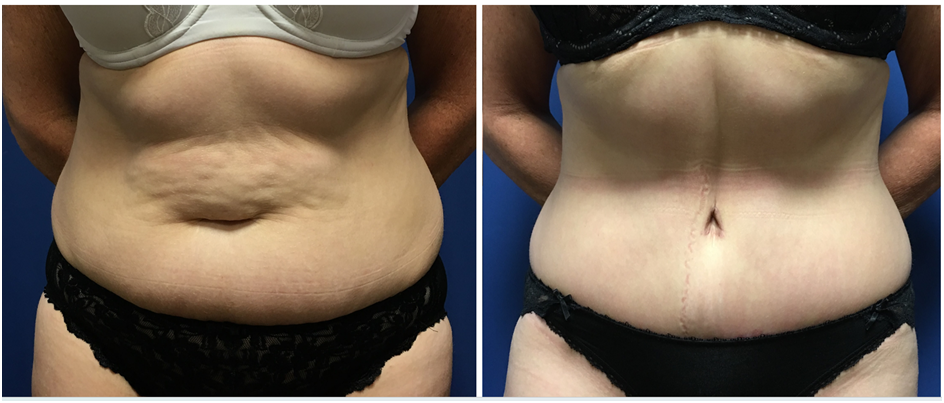Abdominoplasty (“Tummy tuck”) Surgery
Abdominoplasty, also known as a tummy tuck, is a surgical procedure that removes excess skin and fat from the abdomen. It is commonly performed to improve the appearance of the abdomen and waistline, and can also help to relieve back pain and discomfort.
What is Abdominoplasty Surgery?
During an abdominoplasty procedure, the surgeon makes an incision in the lower abdomen, from hip to hip. An incision is also made around the umbilicus (“belly button”). The umbilicus stays where it is, but the remaining skin and fat of the abdomen is lifted and moved downwards. The excess skin and fat from the abdomen is then removed. If required, the abdominal wall muscles are tightened. The wound is closed with dissolving sutures. A new opening is made for the umbilicus. The incision is closed with sutures, and a waterproof dressing will be applied. A binder (like a corset that goes around middle of the abdomen to provide support) needs to be worn for 4 weeks to reduce swelling.
Types of Abdominoplasty
There are two main types of abdominoplasty:
- Full abdominoplasty: This is the most common type of abdominoplasty. It removes excess skin and fat from the entire abdomen, from the belly button to the pubic area.
- Mini abdominoplasty: This type of abdominoplasty removes excess skin and fat from the lower abdomen, from the belly button to the pubic area. No incision is made around the umbilicus
Benefits of Abdominoplasty
Abdominoplasty can offer a number of benefits, including:
- Remove excess skin and fat from the abdomen, especially after weight loss
- Relief from back pain and discomfort
- Decrease the “overhang” or lower abdominal fold, which may in turn decrease rash formation in that crease
Who is a Good Candidate for Abdominoplasty?
Abdominoplasty is a good candidate for people who are:
- In good overall health
- Have realistic expectations about the outcome of the procedure
- Are bothered by the appearance of their abdomen
- Have a stable weight. Ideally, a patient’s Body Mass Index should be close to 30. (Patients with a higher stable BMI with significant symptoms from their abdominal excess tissue are best served by a “wedge lipectomy” without moving the umbilicus)
Before and After Photos
Here are some before and after photos of one of A/Prof Marucci’s previous abdominoplasty patients
You can see more of A/Prof Marucci’s before and after photos in the image gallery by clicking here.
What to Expect Before, During, and After Abdominoplasty
Before Abdominoplasty
During the consultation with A/Prof Marucci, he will take a full medical history from you, in particular any history of previous surgery on the abdomen, allergies, medications, smoking and alcohol. A weight loss history including weight loss surgery is always noted. A/Prof Marucci will then perform a thorough examination of your abdomen, looking for any hernia or muscle separation. One important finding is whether there is excess fat inside the abdomen around the organs (more common in men and can not be treated by an abdominoplasty) or excess fat outside the abdomen, underneath the skin (more common in females and can be treated by abdominoplasty). A/Prof Marucci will outline the nature of the surgery, including potential risks and complications. A consent form will be completed.
Should you decide to proceed with surgery, you will be told when to be at the hospital and when to stop eating a drinking before the surgery.
During Abdominoplasty
- On the day of the surgery, you will be checked into the hospital. You will meet the anaesthetist.
- A/Prof Marucci will draw the surgical plan on you before you go into the operating theatre. You will then go into the operating theatre for the procedure
- The surgery is performed under general anaesthesia (you’ll be completely asleep). Antibiotics will be started. A catheter will be placed in your bladder to measure your urine output – and this means you don’t to get out of bed or use a pan the night of the surgery. Drips will be placed in veins to give you fluid.
- A/Prof Marucci will then perform the abdominoplasty/tummy tuck. The procedure usually begins with liposuction to the flanks, tummy and upper pubic area. Liposuction involves putting in fluid containing local anaesthetic and adrenaline and then suctioning out fat and fluid using narrow long cannulas. Usually around a litre of fat and fluid is removed this way. Then the operating part of the procedure starts
- An incision is made around the (umbilicus) belly button, leaving attached to the abdominal wall where it is. All the skin and fat below the belly button down to the lower abdominal fold is removed. The remaining upper abdominal skin and fat is lifted up off the muscles in the midline until the sternum is reached. At this point, the muscles of the abdominal wall are tightened if needed. Local anaesthetic is injected into the muscles. Drains are placed in the lower part of the wound. The upper tummy skin remaining is stretched down over where the skin and fat have been removed and a new hole is made for the belly button (the bed will be flexed or jack-knifed to make this stretching possible). Dissolving stitches are used to close the lower abdominal wound – which goes from hip to hip.
- A plastic dressing called Comfeel is placed on the lower tummy wound and a large band-aid is placed over the belly button. A binder is placed around your abdomen – this is like a stretchy corset which does up in front with Velcro. You will then go to the ward after you have fully woken up from surgery.
After Abdominoplasty
- The local anaesthetic used during the surgery will last for many hours. After that, you will be given stronger painkillers either through the drip or in tablet form.
- The catheter in your bladder is removed the morning after surgery, and you can start moving around and go to the toilet as normal.
- The drains stay in until they are draining less than 30 mls for 2 days in a row. Most patients stay in hospital for 1 or 2 days and may go home with one or two drains (which are usually removed a few days later).
- You can get out of bed and have a shower even with the drains in the day after surgery. You can use soap shampoo as normal.
- The binder is worn day and night for 4 weeks. You can take it off to shower and to clean it in the washer/dryer. It gives support and decreases swelling, so the more you wear it the better.
Risks and Complications of Abdominoplasty
Abdominoplasty is a safe procedure, but there are some risks and complications associated with it, including:
- Bleeding
- Infection
- Scarring
- Fluid accumulation beneath the skin (seroma)
- Poor wound healing
- Blood clots in the legs (DVT), which can travel to the lungs (PE)
- Numbness or other changes in sensation
For a full list of potential complications of cosmetic surgery, please click here to read the A to Z list.
Recovery from Abdominoplasty
- Once you go home, plan on taking it easy for a few weeks. You can potter around at home. Most patients are driving within 2 weeks after surgery. You can’t lift anything heavier than 3 litres of milk for 4 weeks after the surgery. No swimming and no exercise for at least 4 weeks. Nothing “for” exercise (you can walk – but not for exercise). You should be fine for light work after 2 – 3 weeks.
Finding a Qualified Abdominoplasty Surgeon
It is important to choose a qualified and experienced surgeon for your abdominoplasty procedure. Look for a surgeon who is a Fellow of the Royal Australasian College of Surgeons (FRACS) and is a member of the Australian Society of Plastic Surgeons (ASPS) as well as the Australasian Society of Aesthetic Plastic Surgeons (ASAPS). A/Prof Damian Marucci has a FRACS in Plastic and Reconstructive Surgery. He is on the Education Committee of ASPS and is on the Board of ASAPS. A/Prof Marucci is registered a specialist in plastic and reconstructive surgery with AHPRA.
Conclusion
Abdominoplasty can be an effective way remove excess skin and fat from your abdomen. However, it is important to understand the risks and complications associated with the procedure before you decide to have it. If you are considering abdominoplasty, be sure to consult with a qualified surgeon to discuss your goals and expectations.

